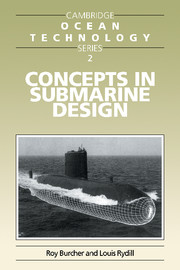Book contents
- Frontmatter
- Contents
- Introduction
- Acknowledgements
- 1 Design in general
- 2 Milestones in submarine history
- 3 Submarine hydrostatics
- 4 The weight/space relationship
- 5 Submarine structures
- 6 Powering of submarines
- 7 Geometric form and arrangements
- 8 Dynamics and control
- 9 Submarine systems
- 10 Considerations of building and costs in design
- 11 Generating a concept design
- Appendix 1 Hydrostatic conditions of flotation
- Appendix 2 Operational practice for keeping in trim
- Appendix 3 Assessing weight and size of variable ballast
- Appendix 4 Submarine pressure hull strength (Prediction of interframe collapse pressures)
- Appendix 5 Estimates of resistance and propulsion
- References and suggested reading
- Index
2 - Milestones in submarine history
Published online by Cambridge University Press: 05 July 2014
- Frontmatter
- Contents
- Introduction
- Acknowledgements
- 1 Design in general
- 2 Milestones in submarine history
- 3 Submarine hydrostatics
- 4 The weight/space relationship
- 5 Submarine structures
- 6 Powering of submarines
- 7 Geometric form and arrangements
- 8 Dynamics and control
- 9 Submarine systems
- 10 Considerations of building and costs in design
- 11 Generating a concept design
- Appendix 1 Hydrostatic conditions of flotation
- Appendix 2 Operational practice for keeping in trim
- Appendix 3 Assessing weight and size of variable ballast
- Appendix 4 Submarine pressure hull strength (Prediction of interframe collapse pressures)
- Appendix 5 Estimates of resistance and propulsion
- References and suggested reading
- Index
Summary
TERMINOLOGY: SUBMERSIBLE AND SUBMARINE
2.1 There are fashions in the terms used to describe vessels capable of operating underwater, which are particularly evident when their history is under review. Some are well-established, like the preference for calling these vessels ‘boats’ rather than ‘ships’ even when – as applies to ballistic missile deploying submarines – their displacements are some tens of thousands of tons. Others, like the differentiation sometimes made between submersibles and submarines, are contentious and can be confusing. The argument for differentiating is that it was not until the advent of nuclear propulsion, and the associated atmospheric control capability enabling a boat to operate entirely submerged throughout a patrol of several months duration, that the ‘true’ submarine had arrived. The complementary picture of the submersible is that it describes a boat obliged to operate mainly on or near the sea surface – in order to have access to the atmosphere for oxygen for breathing and for combustion propulsion engines – and which submerges periodically when on patrol for the purposes of concealment, undertaking an attack with torpedoes or avoiding attack on itself.
Our preference is to use the term ‘submarine’ and we do so throughout this book with its primary focus on naval purposes. We prefer to leave use of the term submersible to commercial circumstances – if that is the wish of the workers in that field – in which it might more closely convey the modes of operation in use there. The fact remains that all submarine boats are submersible – used adjectivally – and to imply a sharp differentiation is misleading.
- Type
- Chapter
- Information
- Concepts in Submarine Design , pp. 11 - 24Publisher: Cambridge University PressPrint publication year: 1994



